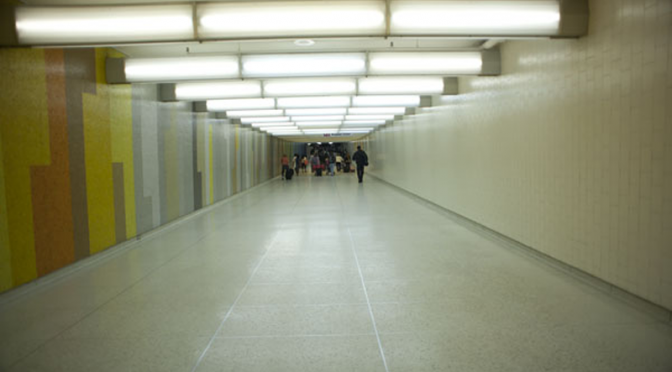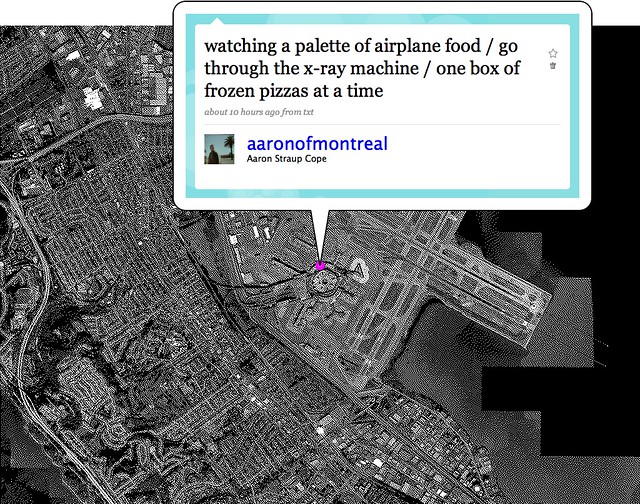There’s a passage in David Pascoe’s book Aircraft
where he talks about how none of the airports of the time were prepared for the introduction of the 747. Specifically there was no part of the physical infrastructure of an airport that wasn’t overwhelmed by the size of and volume of the “jumbo” jet.
None of the waiting areas were large enough to accommodate the number of passengers getting on or off the planes. Often the planes themselves were too big to fit in the loading bays outside the terminals and the few enclosed jetways that had been in use up to that point were too small to even reach the doors on the planes.
Later in the book he goes on to describe a similar clusterfuck ushered in by the hostage taking during the 1972 Munich Olympics and the decision to install security checkpoints and passenger screening areas in airports. The just opened Dallas/Fort Worth airport was particularly hard hit. Although its design was modular and extensible from the outset (with all the terminals as simple semi-circles that could be snapped together like Lego up to the 10 miles in length) the buildings themselves were too narrow to retain any design or aesthetic after they been cut in two by x-ray machines and the lint trap of people waiting to go through them.
I was thinking about this last month when I had the misfortune of flying out of Terminal 7 at New York’s JFK airport. Architecturally, Terminal 7 resembles two staggered butter sticks. The first butter stick is where you check in and is connected to the second “stick” which houses the departure gates by a short flight of stairs. In between the two, just in front of the stairs, is where you go through airport security.
United Airlines flies out of Terminal 7 so at least some of the misery of the security process can be blamed on United poisoning any and everything it comes in to contact with. The rest, though, is a combination of the need for the Transport and Security Administration (and their international counterparts) to indulge itself in ever greater security theater of Broadway musical proportions; the inability of people to imagine any kind of personal efficiency or shared responsibility getting through the line; and a New York City scale “Fuck you, never again” attitude to the process born out of the reality of the 9/11 attacks. All multiplied by the ever increasing numbers of people flying to and from, and especially to and from New York City.
There isn’t much to say about the other terminals at JFK. Both Terminal 4 and the newer addition to Terminal 5 are little more than oversized cargo ship containers with drywall and designer handbag shops but at least they are big enough to dampen the indignity of the fear and paranoia that define contemporary air travel. Put another way: Terminal 7 is just too small and the security line is where everything grinds to a simultaneously depressing and rage-inducing halt and forces everyone to in to a shared despairing for all humanity, all the while with too little space to comfortably take off your shoes.
So I made a website: http://airport-timer.spum.org
Airport Timer is a simple web-based stopwatch application to record how long it takes to get through security at the airport.
Before you get in the screening line you enter, by hand, the three-letter airport code and the name of the terminal you’re in and then press the start button which launches a timer in the background. Then you put your phone (presumably) back in your pocket before you are disappeared for spooking the security agents. When you make it through to the other side you press the stop button which stops the timer and, after a confirmation screen, uploads the airport code, the terminal and the time you spent (measured in seconds) going through security to Pachube. There’s also an option to send a pithy message to Twitter.
That’s it.
The site uses the Twitter API as a single-sign-on provider but that’s mostly as a kind of half-assed throttle on the API that proxies and sends the timing data up to Pachube. Because of the way that the Twitter kids have built their Javascript widgets and because there’s currently no place to store the Twitter user associated with a given report in Pachube there’s a reasonable argument that you shouldn’t need to log in at all. Modulo the part where even Instapaper gave in and forced people to create user accounts on the site. Anyway, you need to log in with your Twitter account.
The sites also uses Pachube as a datastore because it seemed like an obvious place to test the claim, in a networked world, that “every human is a sensor”. Pachube’s data model consists of three nested pieces: Environments (airports), Data Streams (terminals) and Data Points (individual time through security reports). The first two can be assigned additional metadata (tags, location, etc.) but the data points can only contain a timestamp and a value.
Which makes sense but right away the inability to add metadata to individual data points means that I can’t record who just went through security or generate, easily, the “your stuff” style personal reports that people expect from social websites. Arguably Pachube is not a social site except for the part where, in a world where we are all sensors, any centralized time-series service that has humans as inputs will be measured on its ability to abstract the data. Robots may not care (or need) to see all that information bucketed by airport or by Wednesday versus Tuesday but we do.
You could just as easily write a backend for this kind of site using MySQL or Solr. Solr’s ability to facet by date and eventually to do nested faceting (for example, to facet by airport and then for each airport by week or to facet by user and then by airport) makes it an attractive possibility but I’m choosing to use Pachube because it is a logical meeting of minds.
There are no “report” style pages for individuals or airports yet. There’s actually a lot of stuff the site doesn’t do yet. It does not try to retrieve your GPS coordinates automatically or use them to auto-detect your airport or validate that you’re really at Charles de Gaulle aiport and not sitting at a coffee shop in Winnipeg. It does not have a magic auto-completing list of terminals for each airport. It does not (and will never) have heat maps.
Some of these things will come with time. I have already imported all of the whereonearth-airport data in to a Solr instance so auto-detection and validation are both more than theoretically possible. Auto-complete for terminals is little more wrapper code around the Pachube API to pull out the titles of terminals (datastreams) for a given airport (environment/feed). But for now, it’s just a simple thing to record the data and put it somewhere safe and public.





















